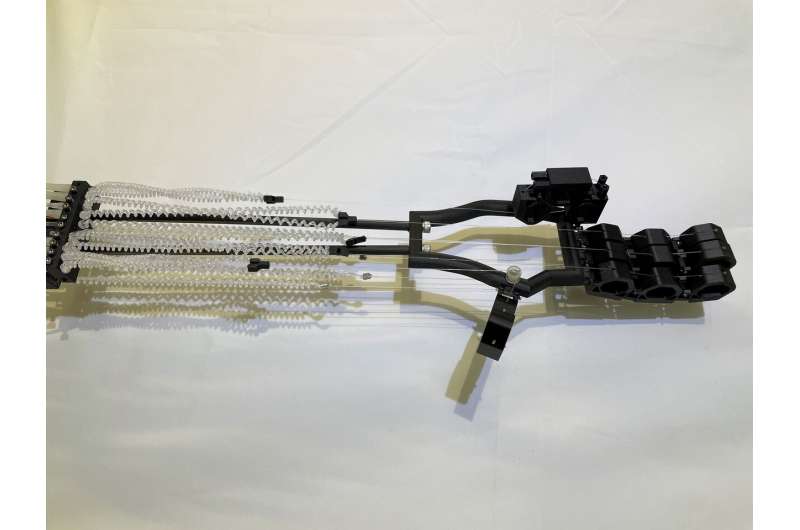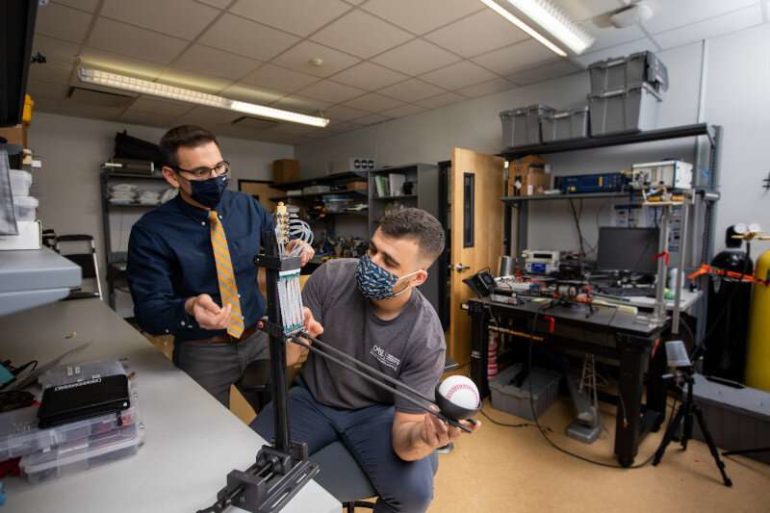In the field of robotics, researchers are continually looking for the fastest, strongest, most efficient and lowest-cost ways to actuate, or enable, robots to make the movements needed to carry out their intended functions.
The quest for new and better actuation technologies and ‘soft’ robotics is often based on principles of biomimetics, in which machine components are designed to mimic the movement of human muscles—and ideally, to outperform them. Despite the performance of actuators like electric motors and hydraulic pistons, their rigid form limits how they can be deployed. As robots transition to more biological forms and as people ask for more biomimetic prostheses, actuators need to evolve.
Associate professor (and alum) Michael Shafer and professor Heidi Feigenbaum of Northern Arizona University’s Department of Mechanical Engineering, along with graduate student researcher Diego Higueras-Ruiz, published a paper in Science Robotics presenting a new, high-performance artificial muscle technology they developed in NAU’s Dynamic Active Systems Laboratory. The paper, titled “Cavatappi artificial muscles from drawing, twisting, and coiling polymer tubes,” details how the new technology enables more human-like motion due to its flexibility and adaptability, but outperforms human skeletal muscle in several metrics.
“We call these new linear actuators cavatappi artificial muscles based on their resemblance to the Italian pasta,” Shafer said.
Because of their coiled, or helical, structure, the actuators can generate more power, making them an ideal technology for bioengineering and robotics applications. In the team’s initial work, they demonstrated that cavatappi artificial muscles exhibit specific work and power metrics ten and five times higher than human skeletal muscles, respectively, and as they continue development, they expect to produce even higher levels of performance.
“The cavatappi artificial muscles are based on twisted polymer actuators (TPAs), which were pretty revolutionary when they first came out because they were powerful, lightweight and cheap. But they were very inefficient and slow to actuate because you had to heat and cool them. Additionally, their efficiency is only about two percent,” Shafer said. “For the cavatappi, we get around this by using pressurized fluid to actuate, so we think these devices are far more likely to be adopted. These devices respond about as fast as we can pump the fluid. The big advantage is their efficiency. We have demonstrated contractile efficiency of up to about 45 percent, which is a very high number in the field of soft actuation.”

The engineers think this technology could be used in soft robotics applications, conventional robotic actuators (for example, for walking robots), or even potentially in assistive technologies like exoskeletons or prostheses.
“We expect that future work will include the use of cavatappi artificial muscles in many applications due to their simplicity, low-cost, lightweight, flexibility, efficiency and strain energy recovery properties, among other benefits,” Shafer said.
Credit card-sized soft pumps power wearable artificial muscles
More information:
D.R. Higueras-Ruiz el al., “Cavatappi artificial muscles from drawing, twisting, and coiling polymer tubes,” Science Robotics (2021). robotics.sciencemag.org/lookup … /scirobotics.abd5383
Provided by
Northern Arizona University
Citation:
Mechanical engineers develop new high-performance artificial muscle technology (2021, April 21)
retrieved 21 April 2021
from https://techxplore.com/news/2021-04-mechanical-high-performance-artificial-muscle-technology.html
This document is subject to copyright. Apart from any fair dealing for the purpose of private study or research, no
part may be reproduced without the written permission. The content is provided for information purposes only.



